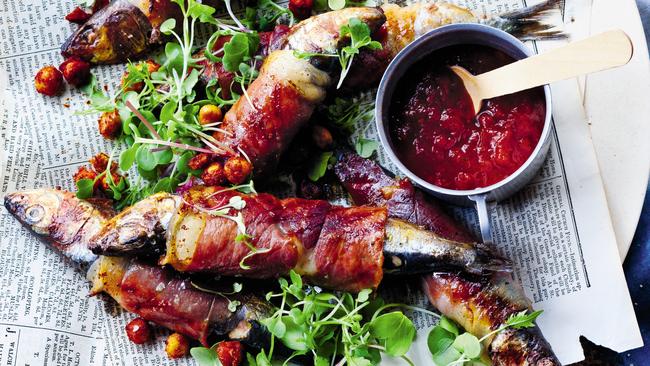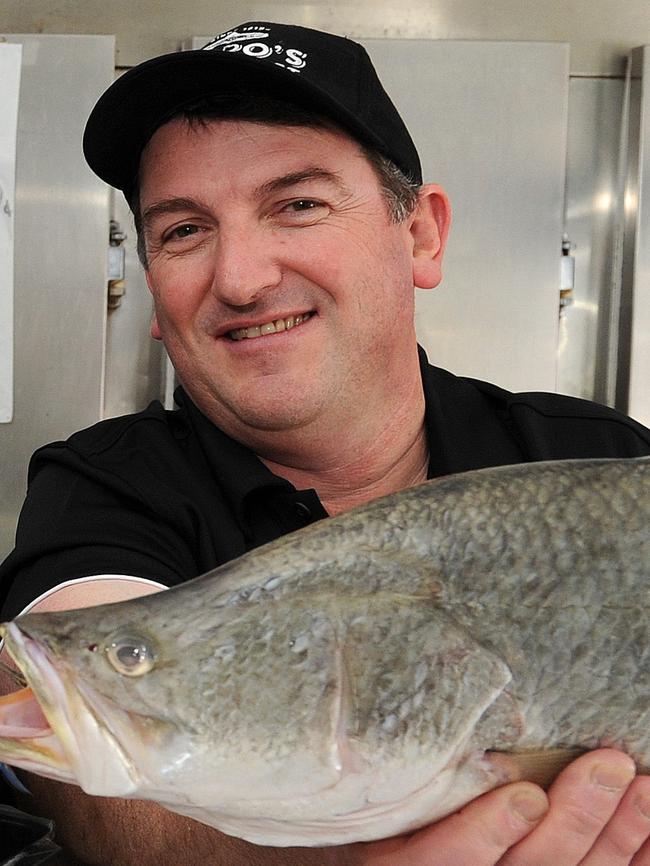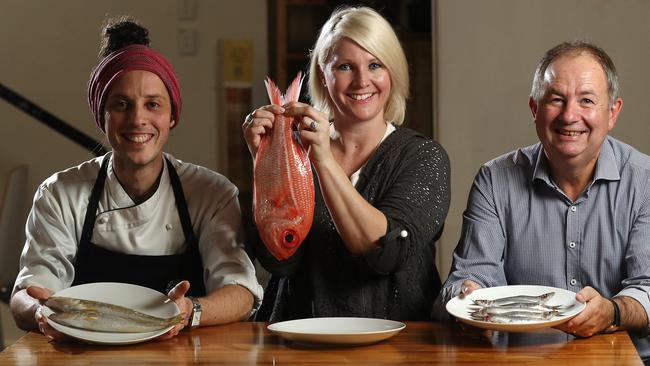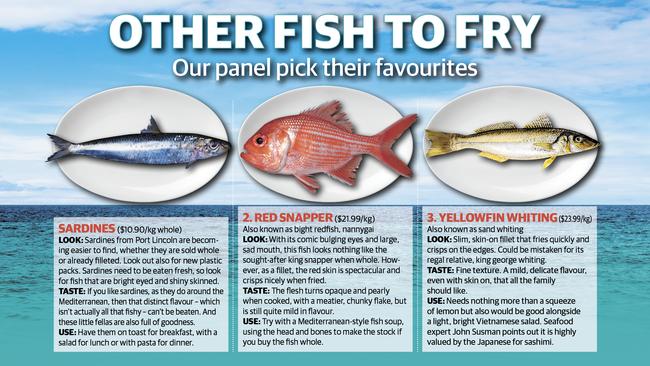Kane Pollard from Topiary Cafe and others put less popular fish to the taste test
SCARED to buy anything other than salmon fillets to cook at home? We’ve got you covered. Simon Wilkinson and a panel of taste testers look at the fish you aren’t buying but should be.
YES, there are, as the saying goes, plenty of fish in the sea. The problem is that, when it comes to taking one home, most of us are very fussy and will only eat a select few.
While farmed Atlantic salmon is one of the biggest sellers in the fish shops, the other in-demand varieties such as snapper, gar and King George whiting are caught wild.
All of these, of course, are lovely fish to eat, but their popularity comes at a cost — and we’re not just talking about the rapid rise in prices that last week saw King George whiting selling for $75/kg at one retailer.
Sustainability is a big issue in oceans around the world and, even in Australia, where fish stocks are carefully monitored, they are a finite resource.

“If people only want to eat King George whiting, it doesn’t matter what the management practices are; it is not going to be sustainable,” says John Susman, co-author of the acclaimed Australian Fish & Seafood Cookbook.
“Our Anglo Saxon culture has left us with a legacy of a relatively limited appreciation for and repertoire of seafood. We tend as a nation to favour the local favourites.”
John, who owns Sydney-based seafood supplier Fishtales, can understand why people might be scared off. He compares a butcher shop, where there are essentially five animals available, to a fish shop where “you can be faced with more than a hundred animals with different handling and preparation requirement and culinary characteristics”.
Market forces
It’s a dilemma Matthew Cappo sees at his Cappo Seafood stall at the Adelaide Central Market, where he strives to offer a varied selection of fish each day.
“People aren’t really confident about cooking fish,” he says. “So they are put off buying something different, particularly if it has skin and bones. They don’t want to waste money if they buy something different and they don’t like it.
“People are more likely to try something different in a restaurant because they put trust in the chef to cook it well.”

Dining out
Enter Kane Pollard from the Topiary Cafe at Tea Tree Gully. As well as using many of the leaves and blooms that reflect the cafe’s gorgeous nursery setting, Kane and his team have a special affinity with fish.
His kitchen wingman, Alex Payne, is from Point Turton on the Yorke Peninsula and has studied aquaculture. During Tasting Australia they teamed up with a fisherman from Alex’s home town for a dinner titled “Salt + Seed”.
However, Kane admits it can be a struggle to convince diners to try something new. While he has a starter of tommy ruff (smoked, with buttermilk and onion oil) on his menu, he also has the ubiquitous whiting.
“If people see King George whiting on a restaurant menu, they know it’s an expensive fish so they are happy to pay a price for that,” he says. “If they don’t know the fish, they might be less likely to pay for that.”

Taste test
To explore the possibilities of some of the lesser-known fish, and hopefully encourage people to try something new, we put a collection of different varieties to the test.
The exercise was restricted to fish sold as fillets, sourced mainly from Cappo Seafoods, so that they could all be prepared in the same manner: a simple pan-fry with oil, butter and seasoning. All priced at less than $30/kg, they were considerably cheaper than the more popular types.
While Alex from Topiary looked after the cooking, Kane and I were joined by Jane Harman, from the Kangaroo Island Store at the market, for the tasting.
We started with yellowfin whiting and worked in a roughly ascending order of fishiness, right up to the sardine, which was the only fish bought whole.
Big winners
The full results of the tasting are in the accompanying panels but a couple of the fillets clearly stood out to us.
The first was the gurnard. “The secret is out; I’m going to buy some of that tomorrow,” enthused Jane, who says her family eats a lot of fish, mainly salmon and whiting.
Matthew Cappo is pleased that the gurnard was popular.
“It’s similar to flathead, but not as sweet,” he says.
“It has a mild flavour and doesn’t fall apart, so it is good for frying, fish and chips, or cooking in a curry.”
The other star was a real surprise. Salmon trout is caught on beaches and jetties around the state but has a reputation for having a strong, fishy flavour. The tasting showed that when it is handled properly — quickly bled and placed on ice — it can be terrific eating.
John Susman is predicting a big future for the variety.
“Salmon trout is a real sleeper,” he says. “It’s a fishery that may make it big over the next five years. It’s incredibly nutritious, it’s local and very sustainable. And dad can leave it on the barbecue for half a can of beer too long and it’s not going to turn to carpet.”
Also getting a unanimous thumbs up were the Port Lincoln sardines, which are now becoming easier to find in shops and are also being packaged as fillets in a plastic pack. Other fish, such as the deep sea bream, would most likely have fared better had they been cooked more gently, such as being steamed or left on the bone.



A valuable lesson
For chef Kane, the exercise has caused him to reconsider his seafood selection — both at home and for the cafe.
“It’s really rewarding to step outside the boundaries and try some different flavours and support sustainability,” he says. “It was quite inspiring. From a chef’s point of view it excited me, because it pushed me to contact our fish suppliers and see what they have on offer, rather than going with the standard list each week.”
He suggests that home cooks, as well as pan frying their fish, try a simple method for chunkier portions known as “en papillote”.
This French technique see the fish wrapped in a well-sealed parcel of baking paper with accompaniments of choice (try lime, lemongrass, chilli with a splash of coconut milk) so it steams and effectively makes its own sauce. Cook in an oven at 180C for 20 minutes — and do be careful when opening the package.
The whole story
Matthew hopes people might start cooking more fish whole, on the bone.
“It always tastes better this way,” he insists. “Even if you can cook it with the skin on, you will get more flavour.”

TIPS FOR FRYING
Alex Payne from Topiary Cafe has these suggestions:
■ Use a mix of oil and butter.
■ Warm the oil in a pan. For thinner fillets, throw some butter in first, wait until it foams and then drop in the fish.
■ For thicker fillets, start cooking the fish in the oil, then add the butter towards the end so it doesn’t burn.
■ To tell if the fish is cooked, press gently to see if the flesh is still springy or, in a thicker fillet, you might be able to fold back a flake and see how it looks inside.
■ Remember, fish will continue to cook out of the pan from residual heat.
■ Consider finishing thicker fillets in the oven.
